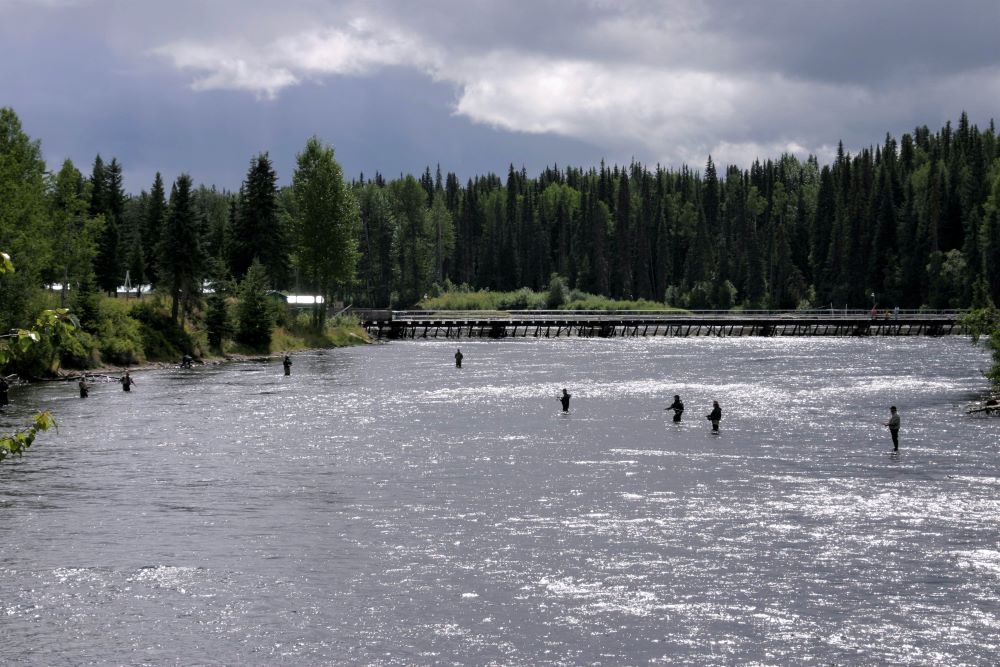The Lake Babine Nation is sounding the alarm over fears this summer’s high temperatures and low rainfall could harm salmon returning to spawn in its territory.
The nation said it will close a popular recreational fishing site on the Babine River to ensure more salmon are able to return to their spawning grounds, a move meant to secure future stocks in an area that produces the vast majority of Skeena River sockeye.
But it’s moving ahead alone, a representative for the nation said, after years of trying to bring Canada’s fisheries regulator to the table.
“This is a serious issue that Lake Babine has been dealing with for probably about a decade,” said Kelly Lindsay, a lawyer for the nation. “They’ve been trying to get the Department of Fisheries and Oceans to take this issue seriously.”
Sockeye fishing on the Babine River is scheduled to open Tuesday and normally runs through August. The Babine River, about 120 kilometres northeast of Smithers, is a popular fly-fishing area with recreational anglers.
The Babine watershed produces about 90 per cent of Skeena sockeye and is “easily one of the most significant spawning grounds in British Columbia and likely in Canada,” Lindsay said.
The salmon face many obstacles in the nearly 500-kilometre journey they take from the ocean to return to the channels where they hatched.
One of those obstacles is the Babine River fish-counting fence, which is jointly operated by the nation and DFO. It’s where researchers determine exactly how many salmon return to Babine Lake.
“Lake Babine Fisheries takes conservation science very seriously,” said Donna MacIntyre, the nation’s fisheries director. “An accurate count is essential for forecasting future runs, and maintaining healthy stocks.”
The fence also creates a physical barrier to returning salmon, causing them to back up below the fence and making it a popular fishing spot with both recreational fishers and grizzly bears. That creates stress on the fish, something further compounded by hot, dry conditions.
“The cumulative effects of high water temperatures and intensive recreational fisheries along this stretch of the river have serious adverse impacts on the migrating talok [sockeye salmon],” MacIntyre said. “We need to give the fish a chance to reach the lake and their natal streams so that they can spawn.”
Over the past month, the region has been at the epicentre of B.C.’s worst-ever wildfire season, with dozens of fires burning in the area and evacuation alerts and orders in place, in some places right up to the southern shores of Babine Lake.
On Friday, the drought level for the Bulkley-Lakes Basin, which includes the Babine, sat at Level 5, making “adverse impacts almost certain.”
Warmer water and lower flows put stress on fish and reduce the number that reach their spawning grounds, Lindsay said, something that’s been established by both Indigenous traditional knowledge and western science.
“The literature is very clear on this,” she said. “The more time salmon spend in these kinds of high-temperature, high-stress areas, there’s a dramatic increase to pre-spawner mortality.”
The nation’s 2021 fishery management plan calls for a closure of the recreational fishery below the fish-counting fence if mean weekly water temperatures reach 15.5 C or if a maximum daily temperature reaches 17.5 C.
This summer, the nation has consistently recorded temperatures of 18 C and higher, well above “the very non-precautionary triggers” for closing the fishery, Lindsay said.
Despite that, she said there’s been “radio silence” from the federal fisheries regulator.
“We tried to meet with [DFO] in July, when the wildfire situation really erupted, the drought really erupted, and it was very clear that we were going to have a significant salmon return this year,” she said. “We had a very offensive meeting with them earlier this week, which showed quite clearly that this is getting absolutely no attention within their system.”
Moving ahead alone leaves the nation — and its members, who visit the remote area to gather their seasonal allocation of food fish — in a vulnerable position, she added, with a risk of confrontation with other fishers.
“We see high potential for conflict here,” Lindsay said. “But we were very clear to DFO that they’ve left Lake Babine no choice.”
In an emailed response to The Tyee, DFO said it has no plans to close the Babine River to recreational fishing. The federal regulator acknowledged the unseasonably warm water temperatures and low flows, but said it believes current returns are sufficient for the First Nation's food fishery, in addition to recreational and commercial fishing.*
The province, which signed a foundation agreement with the nation several years ago, has been more receptive to developing solutions in collaboration with the nation, Lindsay said. “But they don’t have jurisdiction over the salmon,” she said.
She said the nation is urging BC Parks to close the Babine River Corridor Park that encompasses the popular fishing spot, adding that “it’s also been a really bad spring and summer for bears.”
The Tyee reached out to B.C.’s Ministry of Environment Friday to see whether park rangers would enforce a closure. The ministry was unable to provide a response before deadline.
But the nation is hoping that a shared interest in preserving future salmon stocks will be enough to stop fishers from dropping a line in below the fence.
Lindsay said the nation’s representatives would rely on co-operation from people considering fishing below the fish gate.
“They’re not going to physically impede anybody from fishing,” Lindsay said. “There are going to be people on site who are there to educate recreational fishers about why this is important.”
The nation is currently trying to reach as many recreational fishers as possible before they head out to the Babine River, Lindsay said. She added that the nation welcomes fishers to other world-class fishing spots in Lake Babine territory, including the popular Fulton spawning channel and other areas near the community of Granisle.
Salmon returns in the Skeena watershed have been strong so far this year. The Skeena Tyee Test Fishery, which records how many salmon enter the mouth of the Skeena, was reporting Friday that more than one million sockeye have returned to the watershed to spawn so far this year, well beyond the 800,000 threshold to open the recreational fishery.
But strong returns could also bring an increase in the number of fish each person can keep, Lindsay noted. She said as many as possible need to make it through the fence and back to their natal spawning grounds.
* Story updated on Aug. 1 at 2:48 p.m. to include a response from the DFO received after press time. ![]()
Read more: Indigenous, Labour + Industry, Environment

















Tyee Commenting Guidelines
Comments that violate guidelines risk being deleted, and violations may result in a temporary or permanent user ban. Maintain the spirit of good conversation to stay in the discussion and be patient with moderators. Comments are reviewed regularly but not in real time.
Do:
Do not: